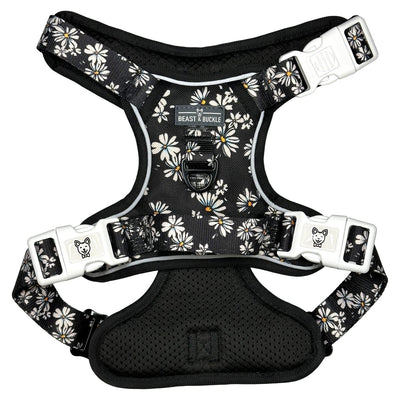How Tight Should a Dog Collar Be?
You want your dog’s collar to be snug and secure, but loose enough that you can fit one or two fingers between the collar and their skin.
Your pup’s collar is an essential part of their wardrobe. It plays a huge role in your pet’s day-to-day life, housing crucial info and serving as the connection point for leashes and more. Plus, cute dog collars are about fashion and function. They show off your pet’s personality and add an extra pop of style on hikes and at the dog park.
Naturally, you want your furry family member to be as comfy and safe as possible every day, and part of that comes down to picking a comfortable collar and making sure it fits just right. But how tight should a dog collar be? In this guide, we’ll go over a few basics to help ensure that your pup’s collar and harness are sized right, whether she’s a tiny terrier or a massive mastiff.
How Tight to Make Your Dog’s Collar
In general, you want your dog’s collar to fit snugly but not be tight against the skin. For small dogs, you want to be able to slide one finger between your dog’s skin and the collar. For large dogs, you should be able to comfortably fit two fingers between your dog’s skin and the collar. This will ensure that the collar doesn’t slip off or cause discomfort.
To test fit, take your pointer finger and index finger and slide them between the dog’s collar and neck, just behind your pup’s head. Your fingers should slide in easily but not feel forced or too snug. If it feels too tight, loosen the collar. If it feels too loose, tighten it a half-inch at a time until the fit is right.
How Tight to Make Your Dog’s Harness
Just like your pup’s collar, a harness can help ensure comfort and safety while adding style. That’s especially true for the reversible dog harnesses in our selection. But they also need to be properly sized for the best results, so make sure you pay close attention to fit. Always select a harness that can be adjusted to ensure that it’s sized exactly to your pet.
Harnesses provide less pressure on the neck, which may be safer for certain breeds, but they can still cause irritation, injury and discomfort if too tight and be ineffective and unsafe f too loose. The two-finger rule applies to your pup’s harness, too. You want it to be snug enough that you can fit one or two fingers beneath the straps at the chest and back.
Find the Perfect Harness For Your Pup
Why Fit Matters
Finding the right fit is key to ensuring that you don’t hurt your dog on walks, especially if you’ve got a pup who’s prone to pulling and lunging.
A collar that’s too tight could cause choking, irritation, neck injury or soreness. On the other hand, a collar that’s too loose is at risk of sliding off, putting your pet at risk of escaping or running away. It could also get snagged on things, which could hurt your dog. Without a secure collar and a good leash, dogs who tend to bolt could find themselves face-to-face with traffic or lost far from home.
Note: The American Kennel Club (AKC) warns against the use of choke collars and prong collars, as these can cause injury, pain or even strangulation.
What’s more, some dog breeds are prone to neck injuries that you should be mindful of when selecting and sizing your collar. For example, Chihuahuas, Pomeranians, Shih Tzus, Lhasa Apsos, toy poodles and Yorkies are prone to a condition called tracheal collapse. These breeds are better off wearing a no-pull harness to avoid putting pressure on the trachea.
Start with a Good Collar
For the comfiest possible results, make sure to start with a high-quality collar that suits your pup’s spunky personality. Whether it’s a dinosaur dog collar or a wild animal print harness, Beast & Buckle has the most stylish and best-fitting styles around. All our collars and harnesses are easily adjustable, allowing for a customized fit no matter what.











Leave a comment